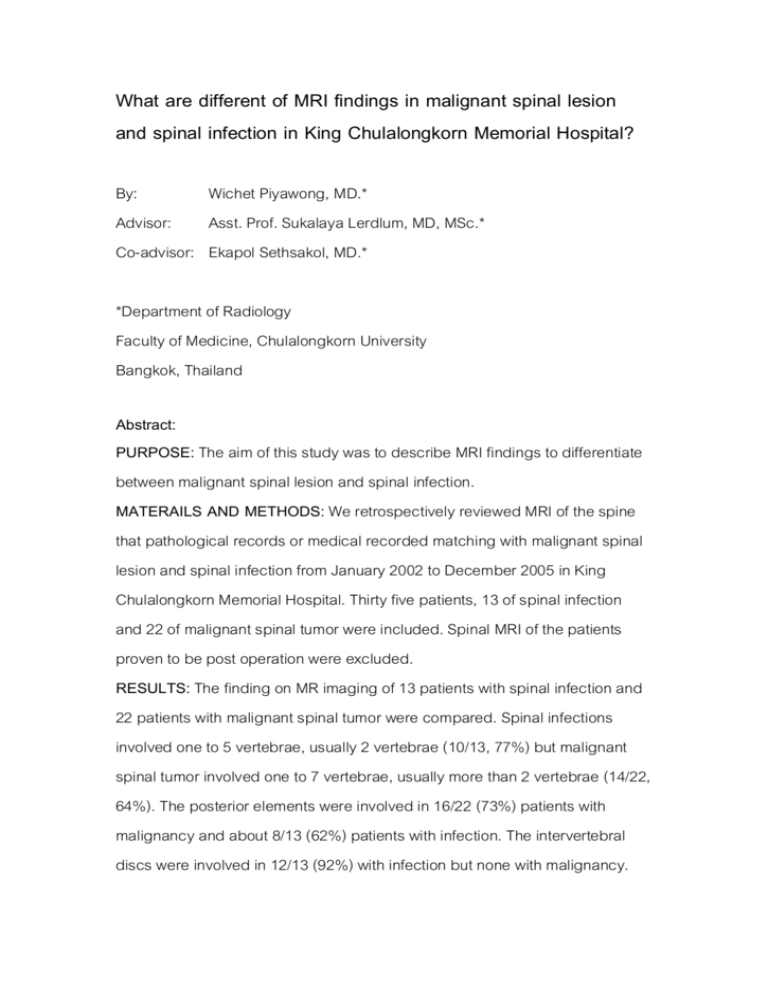What are different of MRI findings in malignant spinal lesion
advertisement

What are different of MRI findings in malignant spinal lesion and spinal infection in King Chulalongkorn Memorial Hospital? By: Wichet Piyawong, MD.* Advisor: Asst. Prof. Sukalaya Lerdlum, MD, MSc.* Co-advisor: Ekapol Sethsakol, MD.* *Department of Radiology Faculty of Medicine, Chulalongkorn University Bangkok, Thailand Abstract: PURPOSE: The aim of this study was to describe MRI findings to differentiate between malignant spinal lesion and spinal infection. MATERAILS AND METHODS: We retrospectively reviewed MRI of the spine that pathological records or medical recorded matching with malignant spinal lesion and spinal infection from January 2002 to December 2005 in King Chulalongkorn Memorial Hospital. Thirty five patients, 13 of spinal infection and 22 of malignant spinal tumor were included. Spinal MRI of the patients proven to be post operation were excluded. RESULTS: The finding on MR imaging of 13 patients with spinal infection and 22 patients with malignant spinal tumor were compared. Spinal infections involved one to 5 vertebrae, usually 2 vertebrae (10/13, 77%) but malignant spinal tumor involved one to 7 vertebrae, usually more than 2 vertebrae (14/22, 64%). The posterior elements were involved in 16/22 (73%) patients with malignancy and about 8/13 (62%) patients with infection. The intervertebral discs were involved in 12/13 (92%) with infection but none with malignancy. The endplates were involved about 12/13 (92%) and 1/22 (4%) in spinal infection and malignant spinal tumor, respectively. The signal intensity of the both infectious and malignant lesions were increased to a variable degree on T2-weighted images. None of all patients with spondylitis present with low signal intensity on T2-weighted images. The patients with a low signal intensity and intermediate signal intensity on T2-weighted images were seen in anaplastic plasmacytoma and HIV with leiomyosarcoma, respectively. CONCLUSION: Spinal infections usually reveal vertebral endplate involvement located adjacent to the intervertebral disc with loss of vertebral endplate definition and usually involvement of contiguous vertebrae. Both malignant tumor and infectious involvement of bone marrow revealed decreased signal intensity on T1-weighted images and increased signal intensity on T2weighted images. Malignant spinal tumor was differentiated from osteomyelitis by lack of disc involvement with tumor cells. The disc outline in osteomyelitis was usually irregular and disc intensity was increased on T2-weighted images. There is vertebral body and together with posterior element involvement with infection disease that must differentiated with spinal tumor. The suggested clue that can help differentiate between malignant spinal lesion and spinal infection are associated findings such as the endplate and disc involvements that mostly found in spinal infection. Keywords: spinal infection, malignant spinal tumor, Magnetic Resonance Image (MRI).








